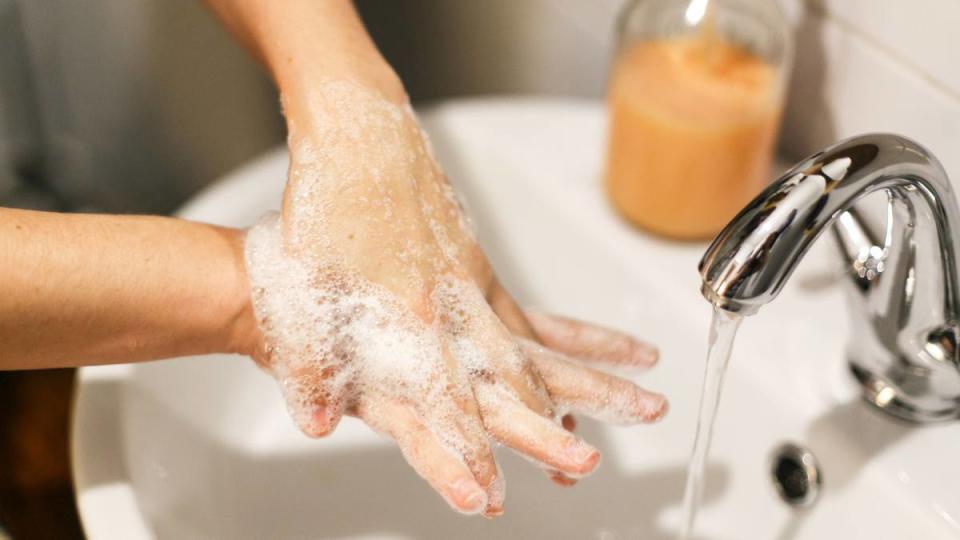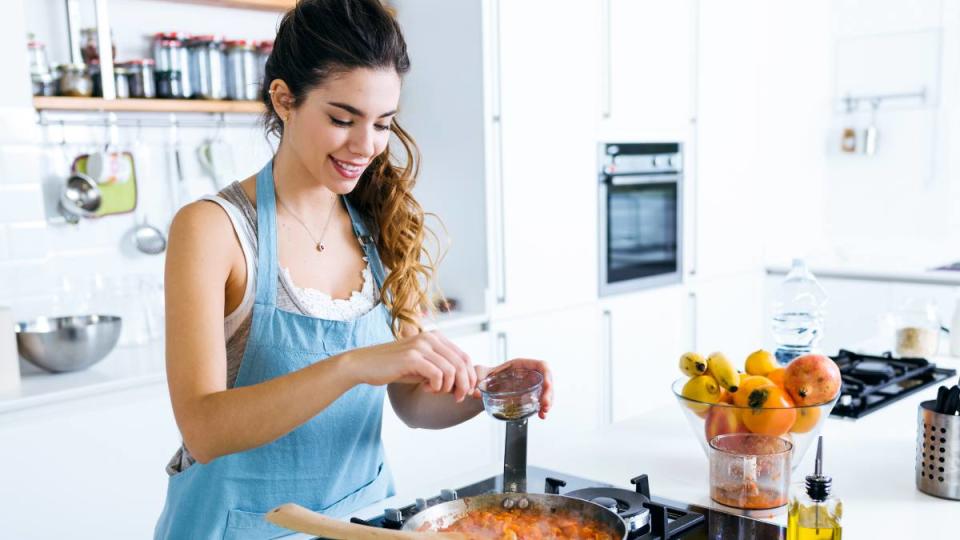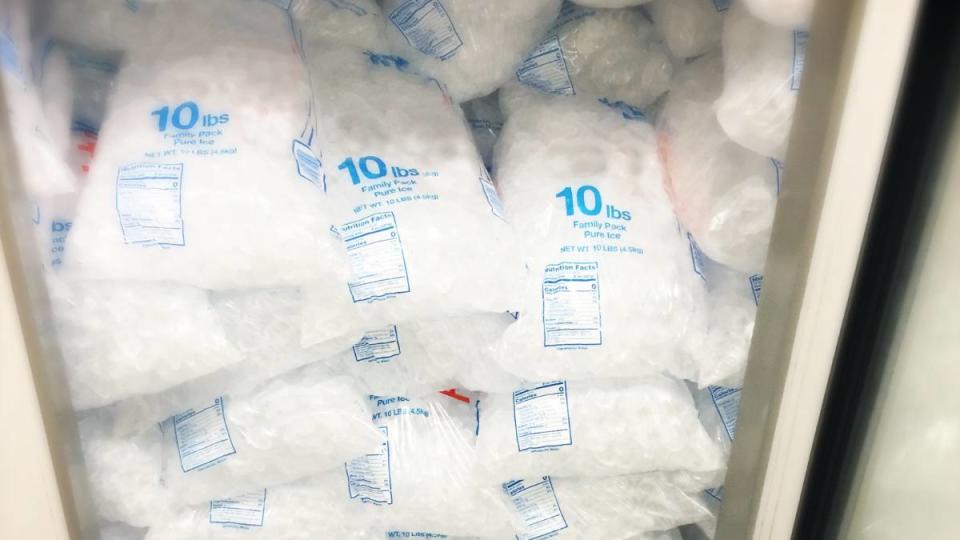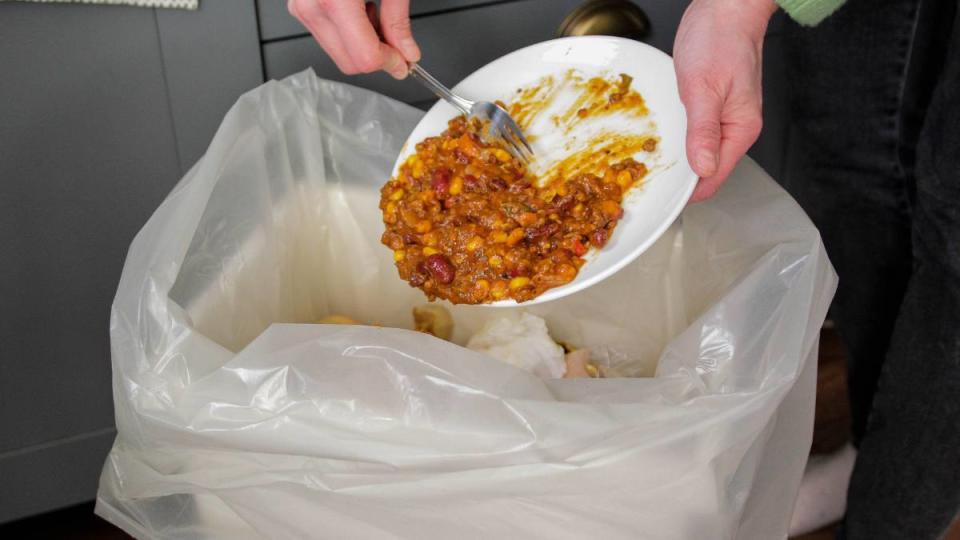CDC Says Food Poisoning Is on the Rise — MDs Share 8 Kitchen Tricks to Keep You Safe
If you've ever experienced foodborne illness, you'd do just about anything to avoid the agony of hours or even days of nausea, vomiting, diarrhea and the other stomach problems it causes. But with CDC data showing cases of food contamination on the rise, many folks are wondering how to prevent food poisoning. And while many people only think of foodborne illness when it comes to picnics, barbecues and dining out, home kitchens are a common source of contamination — year round. So we talked to top doctors to learn how to keep your food (and loved ones) safe in the kitchen.
What is food poisoning?
"Food poisoning occurs when someone ingests food contaminated with bacteria, viruses, parasites or toxins that make you sick,” explains Dahlia Philips, MD, an infectious disease physician and medical director at MetroPlusHealth in New York City. “These microorganisms or toxins spread in the body, causing symptoms like fever, nausea, vomiting, abdominal pain and diarrhea.”
Most instances of food poisoning resolve within 24 to 48 hours, but severe infections increase the risk of dehydration and other more serious health problems. Rather than take that risk, why not try and prevent food poisoning altogether?
How to prevent food poisoning
Dr. Philips says food poisoning prevention starts in the kitchen. A few simple safety precautions make all the difference:
1. Make hand hygiene your #1 priority

Before you do any food prep or cooking, wash your hands thoroughly with soap and warm water. This preventive step takes 20 to 30 seconds but provides amazing results. One study found that handwashing reduces the spread of infectious diseases by up to 48%. Another found that home chefs who washed their hands before cooking were much less likely to develop foodborne illness.
“Food can easily be contaminated if your hands have infectious material on them or have been cross-contaminated from handling other raw foods,” Dr. Philips says. For the best results, wash your hands for at least 20 seconds. As you likely remember from COVID times, that equates to singing “Happy Birthday” twice. Make sure to scrub the tops, palms, and sides of your hands. Get in between your fingers and underneath your fingernails.
Related: How To Know If Expired Hand Sanitizer Is Still Good + What *Never* To Do With It
2. Handle food like a professional chef
High-end restaurants have strict protocols around food handling. Implementing similar practices at home can help prevent food contamination. “Raw meat, like ground beef and chicken, should be separated from other foods,” Dr. Philips says. “These proteins often carry bacteria that die at the appropriate cooking temperature. However, cross-contamination between vegetables and other items can easily occur if appropriate food handling isn’t followed.”
To avoid cross-contamination, designate cooking tools, like graters, peelers and knives for specific purposes. “Avoid cross-contaminating cutting boards and utensils when preparing your food,” says Yelena Wheeler, RDN, a registered dietitian nutritionist for Endomondo. For example, use one knife to cut the protein and a different knife for salad prep. Likewise, use two separate cutting boards and keep different foods apart. For instance, place vegetables on one side of the sink and protein on the other.
Wheeler and Dr. Philips know what they’re talking about! A study published in the journal Food Microbiology found that utensils like graters and knives can easily spread E. coli and salmonella without proper handling.
3. Cook meat to a safe internal temperature

Uncooked proteins, like ground beef, raw chicken and eggs are notorious for containing bacteria and parasites. Dr. Philips says you can significantly reduce your risk of food poisoning by cooking these items to the appropriate internal temperature. Specifically, she recommends following the FDA’s internal temperature guidelines:
Ground beef: 160°F
Poultry: 165°F
Fresh meat steaks, chops, and roasts: 145°F
Ground poultry: 165°F
Fish: 145°F
Consider buying a meat thermometer, as these measurements need to be exact.
Related: How to Tell If Ground Beef Is Bad — And What You Need to Know If It Turned Gray
4. Use antimicrobial seasonings

Another easy way to reduce the risk of food poisoning? Proper seasoning! Believe it or not, certain spices have antimicrobial properties. Case in point: garlic. “Garlic contains allicin, a compound that’s produced when garlic is crushed, chopped or otherwise manipulated,” Dr. Philips says. “It’s effective against a range of microorganisms, including bacteria, fungi and viruses. E.coli is one of the bacteria affected by its antimicrobial properties.”
That’s not all, though! Dr. Phillips says there are several other potentially beneficial spices, including:
Cinnamon
Oregano
Turmeric
Thyme
Cloves
Lemongrass
Sage
Parsley
Indeed! One study published in the journal Nutrients found that cinnamon effectively inhibited bacterial growth. Another, published in the journal Molecules, concluded that lemongrass, thyme and cinnamon were some of the most effective natural antibacterials. Including these seasonings in your dishes won’t eliminate bacteria altogether, but it may provide an extra line of defense.
Related: Spice Brands Without Heavy Metals: Here’s What a Top MD Recommends
5. Look closely at bagged ice

Bagged ice can be a lifesaver when you’re trying to keep things cool, but if you aren’t careful, it can also present risks.
“Always look at the source of where your bagged ice is coming from,” says Amber Robins, MD, a board-certified family medicine physician and best-selling author. “If it’s coming from a manufacturer that has to go through FDA approval, you probably don’t have to worry about contamination. But if you’re getting it from a self-service type of machine where you have to put your hand in and use an ice scoop, and other people can do the same, the risk of foodborne illness or food poisoning is higher.”
Another ice-related no-no: throwing bagged ice on the ground or using a hammer or similar tool to break it up. “I recommend not doing this,” Dr. Robins says. “The bag itself can open in a way that exposes the ice to germs that can cause foodborne illness.”
Dr. Philips says there are several things you can do to ensure the ice you use is safe and contaminate-free. She recommends:
Purchasing ice from reputable sources
Avoiding bags of ice that appear to have been re-frozen
Keeping bagged ice in a clean, cold environment away from raw food
Using clean utensils to scoop and handle the ice
“With bagged ice the risk of food poisoning is minimal to most, but those with compromised immune systems may want to avoid it,” she adds.
Related: 17 Brilliant Uses for Ice Cubes (Besides Keeping Your Drinks Cold)
6. Drink this with your meal
Many people reserve tomato juice for Bloody Marys, but the drink is much more than a hangover cure. A recent study published in the journal Microbiology Spectrum found that tomato juice is particularly adept at killing Salmonella Typhi, which is one of the most common causes of food poisoning. Tomatoes and tomato juice can also destroy other bacteria known to harm digestive and urinary tract health.
Scientists are still trying to understand the mechanisms at work, but the leading theory is that tomatoes contain several antimicrobial peptides. Researchers say they hope this discovery encourages more people to regularly eat tomatoes and drink tomato juice. (Click through to see the weight loss benefits of tomato juice).
7. Be careful with leftovers

After a family picnic or BBQ, it can be tempting to keep all of the leftovers for later, but this isn’t always a good idea if the food hasn’t been stored properly. Without adequate refrigeration, Dr. Philips says bacteria and microorganisms start to take hold.
“The FDA recommends all perishable foods be refrigerated within two hours or otherwise thrown out within one hour if the temperature is over 90°F,” she says.
8. Steer clear of unpasteurized foods
Unpasteurized foods like raw cookie dough, sushi and raw egg whites have lots to offer. You might even find them delicious. But if you have a sensitive stomach or a weakened immune system, try nixing them from your diet. Consider that folks who drink raw milk are 100% more likely to catch a foodborne illness compared to those who drink pasteurized milk. Similarly, eating raw eggs increases the risk of salmonella poisoning. Eliminating these risky foods from your diet can keep you and your digestive system safe.
Although food poisoning can’t be entirely prevented, making small changes at home can protect you and your loved ones. “Unfortunately, most of us will get food poisoning at some point in our lifetime. For most, it’s usually a brief yet uncomfortable illness,” Dr. Philips says. “Following the appropriate food safety precautions can help keep you healthy.”
This content is not a substitute for professional medical advice or diagnosis. Always consult your physician before pursuing any treatment plan.
Click through for more on food safety, keep reading:
This Is the One Place in Your Kitchen Where You Should Never Thaw Frozen Meat
The Top 8 Germ Hot Spots MDs Want You To Know About + Easiest Ways To Clean Them
Expert Advice for Healing the Sneaky GI Infection That’s Making Women Sick & Tired

